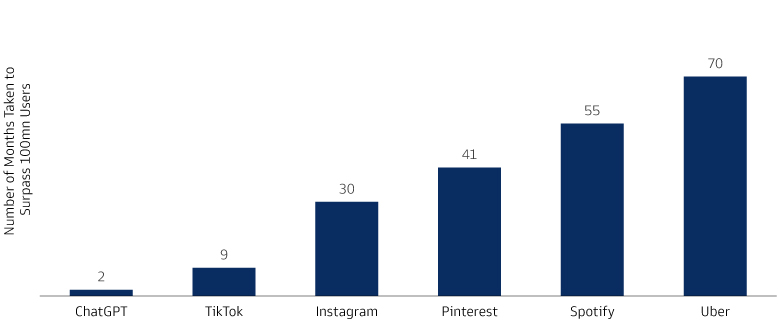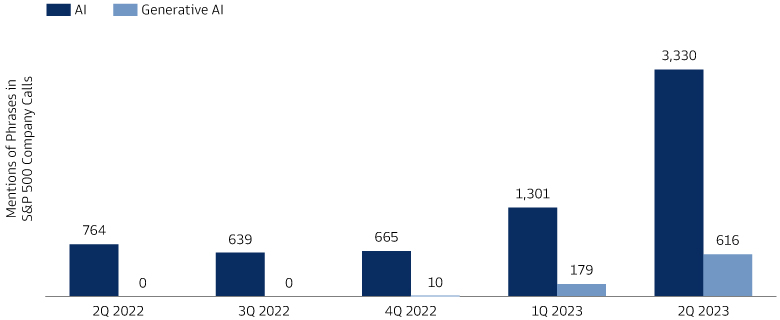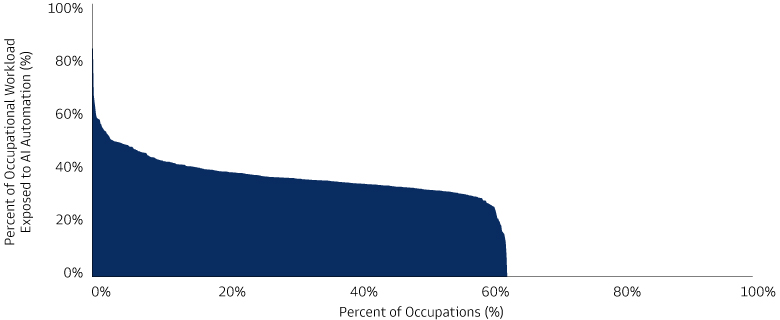An AI on the Future
The idea behind machines being able to think like humans has been around for nearly a century. In the 1940s and 1950s, computer scientist Alan Turing wrote a paper on machines being able to simulate human beings and created the world’s first “Chess-bot.” The term “artificial intelligence” was first used in 1956 by Stanford Professor John McCarthy, who later defined AI as “the science and engineering of making intelligent machines, especially intelligent computer programs.”1 To be sure, machine learning and artificial intelligence are not new concepts in investing, and in fact, both have been used in quant strategies for some time.
The renewed excitement around the topic stems from the generative aspect of AI. In November 2022, OpenAI released the first generative artificial intelligence (GAI) chatbot, ChatGPT. Put very simply, ChatGPT is a computer program designed to simulate conversation with human users. It can tell you a joke. It can report on the weather. It can even write this whitepaper. By using generative AI vs. traditional AI, ChatGPT can not only “hold a conversation” much better than chatbots of yesteryear, but also can translate language to code, write a resume for an entirely fabricated position, or create song lyrics about your favorite holiday in the writing style of Edgar Allen Poe. ChatGPT’s popularity soared, and within 5 days of being released, the software had over one million users. Furthermore, it was one the fastest applications to reach 100mn users ever.

Source: Goldman Sachs Global Investment Research and Goldman Sachs Asset Management. As of June 30, 2023. Chart shows the number of months that each software took to surpass 100 million users. This material is provided for educational purposes only and should not be construed as investment advice or an offer or solicitation to buy or sell securities. Any reference to a specific company or security does not constitute a recommendation to buy, sell, hold, or directly invest in the company or its securities. For illustrative purposes only.
How Does it Work?
GAI’s functionality can be attributed to three key components: 1) neural networks, 2) deep learning, and 3) natural language processing (NLP). Just like human brains, GAI works on a system of multiple neural nodes that process and filter through information in multiple states. Consider a program that is teaching a computer to recognize paintings, and we show this program Andy Warhol’s Campbell’s Soup Cans.2 The initial layer in this artificial neural network is like the optic nerve, feeding raw data from the “eyes” to the “brain.” Data then flows through several neurons, and each has a different function and can communicate with others; perhaps the first is searching for edges and passing information along to the second, which is searching for shapes and passing information along to the third, which is searching for specific features. In this example, each node is an individual knowledge hub that screens and classifies data at each stage, ultimately leading to the model identifying the correct work of art. Taking the analogy one step further, deep learning is a means of machine learning through unstructured data.
Traditional machine learning may have required humans to tell the program specifically what to look for—if a painting contains pop art, the artist may be Andy Warhol or Keith Haring. By showing the program thousands of depictions of pop art, it can draw its own conclusions and further improve its analytic capabilities. Finally, NLP enables computers to interpret speech, gauge interest, read text, and evaluate images, both with syntactic and semantic analysis. By using NLP, a GAI model that is shown Campbell’s Soup Cans may be able to posit conclusions on the meaning behind the painting: perhaps Warhol depicted what he did to show that art should be for everyone, not just cultured curators, or maybe he was just an avid soup consumer! Put very simply, neural networks, deep learning, and NLP are all means of how AI thinks.
Is GAI Just Another Hype Cycle?
One of the key points of skepticism around investing in artificial intelligence is the debate as to whether it is another bubble. We argue that it is not, because AI is already making an important impact in investing, and because funding for GAI has already surpassed that of previous hype cycles at their respective peaks. Artificial intelligence and machine learning have been used in quantitative investment strategies for several years. Anyone who has ever used a trading algorithm has likely taken advantage of AI in investing, as many of these algorithms are making decisions based on large data sets at high speeds or exploiting possible arbitrage opportunities. AI can also be used to optimize asset allocations to construct portfolios that might perform better than those constructed with traditional techniques, aid in pre- and post-trade analysis, and analyze market and credit risk. While less known, some large language models may also be used in both sentiment analysis—e.g., comprehending subtext of corporate earnings calls—and portfolio optimization. Most recently, a GAI model was created to analyze Federal Reserve statements and assign them a “Hawk-Dove score,” with the goal of detecting potential trading signals.3 We expect these links between AI and investing to become even more intertwined as society becomes more familiar with the technology.
Another indication that AI may persist for some time is the amount of funding that is being deployed. In the first quarter of 2023, GAI companies raised $2.3bn from venture capital firms. Quarterly VC fundraising for the metaverse at its peak in 2021 was only $2.1bn. Large corporations are taking a similar interest; in 4Q 2022, there were only 10 mentions of “generative artificial intelligence” on S&P 500 company correspondences. We believe this stemmed from Microsoft’s purchase of a $10bn stake in OpenAI. In 2Q 2023, this number increased drastically, and even Mark Zuckerberg, who changed the name of his company to Meta in 2021, said, “[Meta’s] single largest investment is in advancing AI.”
Of course, using AI also includes challenges. For instance, increasingly opaque algorithms can make it difficult for humans to monitor, evaluate, and understand how AI models will respond to inputs, anomalous events, or complex tasks. Additionally, AI relies on large amounts of data, especially in the learning phase. The quality and availability of this data can lead to improper calibration, skewing results.
We recognize that there may be growing pains with AI and acknowledge the potential risk of markets getting ahead of themselves. But in our view, GAI is here to stay.
Economic Impact of GAI
Something else that sets GAI apart from many prior technological advancements is its potentially drastic impact on economies. In the long term, we believe that widespread adoption of GAI has the potential to materially change our lives, interactions, and all of human existence. Goldman Sachs Global Investment Research economists have likened the impact of GAI to two milestone inventions in human history: the electric motor in 1890 and the personal computer in 1981. In each of these instances, the productivity “boom” did not begin until roughly 50% of businesses adopted the technology—a threshold that took 20 years to reach. After reaching this threshold, however, labor productivity grew by 1.5 percentage points annually for over a decade, and we believe that widespread adoption of GAI could yield similar effects to the tune of a 7% annual increase in global GDP, which stems from two main channels. First, many workers are employed in occupations that are partially exposed to AI automation. If AI can increase workers’ capacities, then plausibly, said workers may direct some of their newfound time toward more productive activities. Second, if workers do end up being displaced by AI automation, we believe that these workers will eventually become reemployed, and therefore boost total output. The size of GAI’s impact will ultimately depend on its true capabilities and adoption timeline, but we believe that it is possible to begin reaping the economic benefits of GAI sometime in the latter years of the 2020s.
Technological Impacts of GAI
AI has seemingly been the darling topic on company calls across industries. As of the end of June, the phrase was mentioned 3,330 times according to Bloomberg.4 The surprising aspect of this viral growth, aside from the broad volume of mentions, has been the range of companies—from Microsoft to Kraft to Moderna to Zoom—that are trying to incorporate AI into their businesses. As previously mentioned, the most widespread use of GAI thus far has been chatbots. Following Microsoft’s substantial investment in OpenAI for the use of ChatGPT, other tech companies have increased efforts in making their own chatbots (Google’s Bard, Snapchat’s “AI”). The functionality of chatbots extends far beyond jokes and weather updates. Chatbots have the potential to revolutionize customer service and improve the efficiency of human searches/research—ask ChatGPT to plan a travel itinerary of a camping trip for proof. Additionally, chatbots are becoming smarter and more sophisticated at incredible rates. Chatbots are not the only notable application of GAI. Through NLP, AI is being used to help programmers write original code. In some instances, according to Goldman Sachs Chief Information Officer Marco Argenti, developers are accepting nearly 40% of code written by AI,5 which could boost programming productivity by double digit percentages. Eventually, AI will be used in entertainment, medicine, and nearly every industry.

Source: Bloomberg and Goldman Sachs Asset Management. As of June 30, 2023. Chart shows number of mentions of “AI” and “Generative AI” in company calls by quarter. This material is provided for educational purposes only and should not be construed as investment advice or an offer or solicitation to buy or sell securities. For illustrative purposes only.
Investment Impact of GAI
Outside of the question, “is AI going to take over humanity,” investors are most curious as to where they can strategically position their portfolios to take advantage of its new developments. Given the different components of the GAI tech stack—including apps, hardware, cloud platforms, foundation models, and model hubs—companies may want to consider tech investments to capitalize on the benefits of GAI.
In our view, the groups who may prosper the most are 1) large companies with infrastructure who can integrate AI with their existing platforms, 2) companies that produce both the components of AI and build/license GAI models, and 3) companies outside of technology who are most willing to scale their own AI adoption. Unsurprisingly perhaps, large tech companies with strong infrastructure stand to gain from the advent of new tech. By implementing AI models into existing productivity tools, workers could benefit from increased efficiency and the ability to leverage multiple sources of data in one application. For example, someone creating a presentation could use GAI to pull notes from a text document and populate a slide in a slideshow, all without leaving the slideshow application. Furthermore, GAI can help employees who are not as well-versed in software to take full advantage of the tools available to them.
Outside of just productivity, tech companies may be positioned to quickly adopt GAI in search engines—DevOps and cybersecurity to name a few. Second, there is now a global demand for GAI models, but not all companies have the infrastructure/resources to build their own. For a smaller company looking to increase productivity, it makes sense to subscribe to use an AI model that was created externally. We also believe manufacturers of graphics processing units (GPUs) and other components of AI may be able to succeed. Finally, given that roughly 66% of jobs are exposed to AI automation, we believe that any company that can embrace GAI to improve its efficiency could benefit. Healthcare is just one example of a sector in which GAI tools could be leveraged for patient diagnosis, personalized treatment plans, and novel drug design. There seems to be a plausible case for GAI in just about every industry, and although there are very few jobs in which GAI can automate more than half the work, we believe widespread adoption of GAI could provide a double-digit productivity boost in many fields.
Despite being in the early stages of discovery and adoption, the potential advantages of GAI are hard to ignore. However, the narrowness of the recent market rally may be evidence that the markets may not have fully embraced AI yet. Because it is unclear how exactly the adoption of GAI will impact company fundamentals, it may be too early to tell if GAI companies are overvalued, and it is unclear if traditional valuation methods should be applied in this space. Having said that, some tech valuations are severely stretched. Investors may have difficulty in selecting future GAI winners at the right price. As managers continue to study the space, the markets may dictate new valuation dynamics, potentially with the help of AI.
Key Risks
We see three main risks when it comes to widespread adoption of AI technology: 1) privacy and copyright issues, 2) ethical issues, and 3) labor displacement. The large language learning models upon which AI platforms are built leverage huge amounts of data to train, meaning that a cyber-attack or data breach could potentially cause significant damage. More unique to GAI is the risk of copyright infringement. While still early, notable examples of AI “theft” have come from the music industry, in which sound engineers have been able to use artificial intelligence to create original music with AI versions of famous artists’ voices. In some instances, the replication is uncanny. There is also the matter of ethical issues when it comes to using AI, notably in the forms of plagiarism and misinformation. As mentioned earlier, GAI models are trained on existing available data, so the likelihood of content being plagiarized is higher, and it is the user’s responsibility to sensibly use the content generated. Additionally, GAI tools have been under scrutiny around the accuracy of information being disseminated, which can be dangerous to users like asset managers who are unable to verify them.

Source: US Department of Labor’s Occupational Information Network (O*NET), Goldman Sachs Global Investment Research, and Goldman Sachs Asset Management. As of May 30, 2023. Chart shows the occupation-level distribution of the share of tasks that AI can perform, with occupations and tasks based on the US Department of Labor’s Occupational Information Network.
Despite the dangerous risk that misinformation poses, the risk that we feel is most impactful is labor displacement. We believe that approximately two-thirds of US occupations are exposed to some degree of AI automation, with particularly high exposures in administrative and legal professions but low exposures in construction and maintenance. An estimated 7% of jobs could be displaced.6 However, history shows that worker displacement from automation is mostly offset by the creation of new jobs. Sixty percent of the jobs that exist today did not exist in 1940, and over the last 80 years, the technology-driven creation of new jobs has accounted for 85% of employment growth.7 We expect AI to be no different, with new roles being created in data science, AI research, and engineering, to name a few. Additionally, while the future interplay between labor unions and GAI is unclear, we have already seen that unions in industries like airlines, medicine, and entertainment writers are navigating the nuances of emphasizing human involvement in jobs while seeking protections from companies and government regulations against being replaced completely.
We feel that GAI could drastically change both the economic landscape and the investment landscape. As with many new technologies, there are certainly risks, but we believe that the benefits of adoption of GAI far outweigh the costs. Through GAI, humans are given some of the most futuristic “game pieces” the world has ever seen with no gameboard or instructions on how the game should be played. That is where the art and imagination of artificial intelligence takes hold. As civilization starts to learn how to wield these tools, we believe the possibilities for innovation could be truly endless.
1 John McCarthy, “What is Artificial Intelligence?” As of November 12, 2007.
2 Museum of Modern Art, Andy Warhol’s Campbell's Soup Cans, 1962.
3 Bloomberg, “JPMorgan Creates AI Model to Analyze 25 Years of Fed Speeches.” As of April 26, 2023.
4 Bloomberg and Goldman Sachs Asset Management. As of June 30, 2023.
5 The Wall Street Journal, “Goldman Sachs CIO Tests Generative AI.” As of May 2, 2023.
6 Goldman Sachs Global Investment Research, “The Potentially Large Effects of Artificial Intelligence on Economic Growth.” As of March 26, 2023.
7 Goldman Sachs Global Investment Research, “The Potentially Large Effects of Artificial Intelligence on Economic Growth.” As of March 26, 2023.